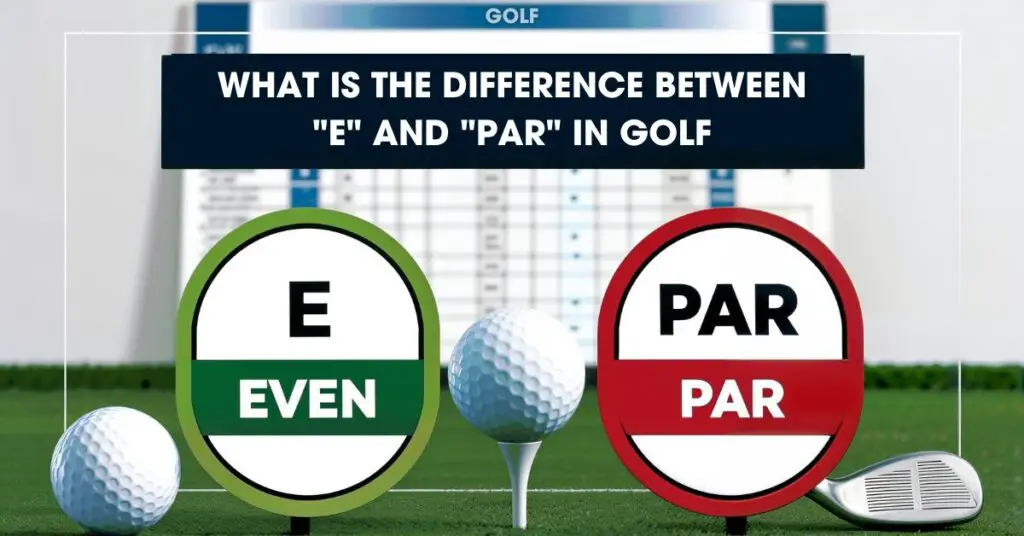If you’ve ever watched a golf tournament or checked the scores online, you might have come across the letter “E” on the golf leaderboard and found yourself wondering what that elusive “E” really signifies. Is it a score, a status, or a secret code only seasoned golfers understand? It’s easy to get confused by all the different symbols and numbers in golf scoring, and understanding what “E” means can clear up some of that mystery. Whether you’re a beginner or just looking to understand the game better, knowing what “E” stands for is essential.
Many people, even avid golf fans, sometimes struggle to grasp the meaning behind these scoring terms. According to a recent survey, nearly 40% of amateur golfers don’t fully understand golf scoring. This confusion can make it harder to enjoy watching the sport or to keep track of your own progress on the course.
In this article, I’ll break down what does E mean in golf, why it’s important, and how it affects your game of golf. So, let’s dive in and make sense of this common but often misunderstood golf term.
Table of Contents
ToggleWhat Does E Mean In Golf?
In golfing, “E” also refers to “Even” or “Even Par.” The term means that a player has used the same number of strokes as the par of a course or par on a hole. For instance, if a course has a par of 72 and a golfer’s total score matches that, they are considered “even par” or “E.” To achieve this, the golfer must consistently get the ball in the hole using the precise number of strokes dictated by the par for each hole.
This is something that is quite familiar on leaderboards, especially in professional games. This is denoted by ‘E’ after the name of a golfer and indicates that his or her score is exactly average or does not exceed of the expected number of strokes. In other words, they’ve played the course exactly as intended.
Knowing “E” is crucial since it provides you with a clear picture of how a golfer is performing relative to the course’s difficulty. In contrast to other scoring terminology such as birdies or bogeys, which represent scores that are either below or above par, an “E” represents a simple indicator of playing to the expected standard.
Importance Of Understanding "E" In Golf Score

Understanding what “E” means in golf is crucial for several reasons. First, it helps you interpret leaderboards accurately. When you know that “E” stands for “Even Par,” you can quickly see how players are performing relative to the course.
Second, knowing the significance of “E” enhances your appreciation of the game. Golf is a sport where small differences in scores can have a big impact. Recognizing that a player at “E” is meeting the course’s standard helps you gauge their skill and consistency.
Additionally, for those playing golf, aiming for “E” can be a practical goal. It means you are playing each hole as intended without exceeding the expected strokes. This understanding can guide your strategy and shot selection during a round.
Finally, being familiar with “E” allows you to communicate more effectively with other golfers. Whether you’re discussing a professional tournament or your own game, knowing what “E” means ensures everyone is on the same page. It’s a simple but essential part of golf knowledge.
How To Calculate "E" In A Golf Round?

Calculating “E” in a golf round is quite easy. “E,” or “Even Par,” means that the particular golfer has used the exact number of strikes as the par of the course. Every hole of a golf course has its specific par and par is the number of shots that would be considered as an average number of strokes for a professional player. The average total par for an 18-hole course common standard is the range of 70/72.
To determine if a golfer is “even” or “E,” you simply compare their total strokes for the round to the course’s total par. If a golfer takes the same number of strokes as the total par, they are at “E.” For example, if a course’s par is 72 and the golfer finishes with 72 strokes, they are even par. The calculation involves adding up the strokes taken on each hole and comparing the total to the course’s par.
Example Calculation
Let’s say you’re playing on a course with a par of 72. If you finish the round with a total of 72 strokes, your score is “E.”
Hole-by-Hole Breakdown:
- Hole 1: Par 4, you take 4 strokes (even)
- Hole 2: Par-3, you take 3 strokes (even)
- Hole 3: Par 5, you take 5 strokes (even)
- ……
You are “E” for the round if this pattern continues, and your total for all 18 holes equals 72 strokes (the par for the course).
What Is The Difference Between "E" and "Par" In Golf?

Understanding the fundamental difference between “E” and “Par” is critical when calculating golf scores. Although it is easy to claim that both concepts have a connection and refer to the same phenomenon they are extremely different.
Par
In golf, “par” represents the number of shots an experienced golfer should take while complete the particular hole or the entire golf course. There are usually 3, 4, or 5 on each hole and the point objective in each hole is also known as its par. Generally, the average aggregate par of a standard golf course that contains 18 holes is approximately around 72. Par sets the benchmark for performance on a given hole or course.
E (Even Par)
“E,” or “Even Par,” indicates that a golfer’s total strokes match the course’s par exactly. If the course par is 72 and a golfer takes 72 strokes, they are at “E.” It reflects playing each hole exactly as expected without any over or under-par performance.
Key Differences
- Concept: Par is a target score for each hole and the whole course. “E” shows that a golfer has met this target precisely.
- Usage: Par is used to set expectations and benchmarks. “E” is used to show that a golfer’s score aligns with these expectations.
- Scoring: Par values vary per hole (e.g., par 3, par 4). “E” is a single value showing no deviation from the total par.
Practical Example
Consider a course with a par of 72:
- If a golfer scores 70, they are 2 strokes under par, noted as -2.
- If they score 74, they are 2 strokes over par, noted as +2.
- If they score 72, they are “E,” meaning they played the course exactly on par score.
Understanding these differences helps you better interpret scores and appreciate the nuances of golf scoring.
Strategies For Achieving "E" in Golf

Achieving “E” in golf, or playing to even par, is a goal that requires consistency, skill, and strategic thinking. Here are some key strategies to help you reach this benchmark:
- Solid Fundamentals: Focus on perfecting your grip, stance, and swing. Consistency in these basics sets the foundation for a reliable game.
- Accurate Putting: Spend ample time practicing your putting. A strong putting game can save strokes and keep you on par.
- Course Management: It will hundred percent helpful to understand what to expect when it comes to the layout of the course and the difficulties. It is always recommended to aim to avoid the danger areas that keep you in play, even if they are not the shortest route to the hole.
- Focus on Short Game: The area around the green is very sensitive and can either make or affect your score. Take a few shots to practice chipping, pitching & putting regularly to ensure you can save strokes when approaching the hole.
- Consistent Ball Striking: Try, as much as you can, make your drives and fairway shots exact to your targets. Balancing that will keep you out of trouble and will also help you with nice clean hits on the further approach shots.
- Mental Toughness: Do not get nervous and stressed in the round. Golf is not just a sporting activity or rather movements of the body as it is a game that involves the use of the brain. Being positive and reducing stress will help you make smart decisions under pressure.
- Physical Fitness: Maintain good physical condition to ensure you have the stamina and flexibility needed to perform well throughout the round. Regular exercise and stretching can improve your swing and reduce fatigue.
- Practice Routine: Develop a balanced practice routine that includes driving, iron play, short game, and putting. Consistent practice will build muscle memory and improve your overall game.
- Course Familiarity: Play the course multiple times to become familiar with its nuances. Knowing where to place your shots and understanding the greens can give you a strategic advantage.
- Equipment Check: Ensure your golf clubs and golf balls suit your game and the course conditions. Properly fitted equipment can enhance your performance and consistency.
- Keep a Scorecard: Track your scores and identify patterns. Understanding where you typically lose strokes helps you focus your practice sessions.
By combining these strategies, you can increase your chances of achieving “E” in your golf rounds. Remember, consistency and smart play are key to reaching even par.
Conclusion
Understanding what does E mean in golf scores is essential for anyone who wants to enjoy and excel in the game more deeply. “E,” or “Even Par,” indicates that a golfer has played the course exactly as expected, matching the par for each hole and the entire course. This golf score terms term helps you quickly see how players are performing and gives you a clearer picture of their skill and consistency.
Knowing the difference between “E” and par clarifies how golf scoring works. Par sets the target for each hole, while “E” indicates you’ve hit that target exactly. Calculating “E” involves adding up your total strokes and comparing them to the course’s par.
Achieving an “E” requires a combination of solid basics, strategic course management, mental toughness, and regular practice. To increase your chances of playing even par, concentrate on improving your short game, continue hitting the ball accurately, and maintain a positive mindset.
Mastering the golf “E” concept will improve your understanding and fun of the game. Understanding what “E” represents will help you greatly whether you’re playing a round of golf or watching a tournament. You’ll now understand exactly what the letter “E” means and why it matters the next time you see it on the scoreboard.
FAQ’s
On a PGA leaderboard, “E” represents “Even Par.” This signifies that the golfer’s total score equals the course’s par, indicating that they played the course precisely as expected, neither above nor below par.
In disc golf, “E” stands for “Even,” meaning the player’s score is the same as the course par.
Yes, “E” (Even Par) is considered a good score in golf since it means the player completed the course exactly as it planned, with no strokes over or under par.

With several years of experience in golf, Golf Golz are dedicated to helping golfers elevate their game through innovative training techniques, premium equipment, and expert insights. From mastering your swing to conquering the course, we bring you strategies and tools designed by world-class instructors to help you play your best golf yet.



